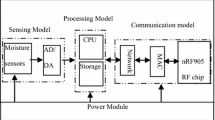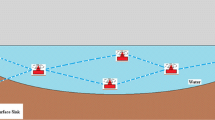Abstract
Wireless Underground Sensor Networks (WUSNs) constitute one of the promising application areas of the recently developed wireless sensor networking techniques. WUSN is a specialized kind of WSN that mainly focuses on the use of sensors at the subsurface region of the soil, that is, the top few meters of the soil. For a long time, this region has been used to bury sensors, usually targeting irrigation and environment monitoring applications, although without wireless communication capability; WUSNs promise to fill this gap and to provide the infrastructure for novel applications. The main difference between WUSNs and the terrestrial WSNs is the communication medium. In fact, the differences between the propagation of electromagnetic (EM) waves in soil and in air are so significant that a complete characterization of the underground wireless channel was only available recently. This chapter presents advanced channel models that were developed to characterize the underground wireless channel considering the characteristics of the propagation of EM waves in soil and their relation with the frequency of these waves, the soil composition, and the soil moisture. Additional important aspects such as the burial depth, the reflection, the refraction, and multi path fading effects on the EM waves are also considered. The results from the field experiments in conjunction with the simulation results, both considering the path loss and the bit error rate, prove the feasibility of WUSNs. The chapter concludes with an outlook on potential research topics that are essential for the realization of WUSNs.
Access this chapter
Tax calculation will be finalised at checkout
Purchases are for personal use only
Similar content being viewed by others
Reference
I. F. Akyildiz, W. Y. Lee, M. C. Vuran, and S. Mohanty, “NeXt generation/dynamic spectrum access/cognitive radio wireless networks: a survey,” Computer Networks Journal (Elsevier), Vol. 50, pp. 2127–2159, September 2006.
I. F. Akyildiz and E. P. Stuntebeck, “Wireless underground sensor networks: research challenges,” Ad Hoc Networks Journal (Elsevier), Vol. 4, pp. 669–686, July 2006.
I. F. Akyildiz, W. Su, Y. Sankarasubramaniam, and E. Cayirci, “Wireless sensor networks: a survey,” Computer Networks Journal (Elsevier), Vol. 38, No. 4, pp. 393–422, March 2002.
I. F. Akyildiz, Z. Sun, and M. C. Vuran, “Signal propagation techniques for wireless underground communication networks,” Physical Communication Journal (Elsevier), Vol. 2, No. 3, pp. 167–183, September 2009.
C. Alippi and G. Vanini, “Wireless sensor networks and radio localization: a metrological analysis of the MICA2 received signal strength indicator,” in Proceedings of IEEE Workshop on Embedded Networked Sensors, Florida, USA, November 2004.
J. Behari, “Microwave Dielectric Behavior of Wet Soils”, Springer, New York, 2005.
A. Chehri, P. Fortier, and P. M. Tardif, “Application of ad-hoc sensor networks for localization in underground mines,” in Proceedings of Wireless and Microwave Technology Conference 2006 (WAMICON ‘06), Florida, USA, December 2006.
A. Chehri, P. Fortier, and P. M. Tardif, “Security monitoring using wireless sensor networks,” Communication Networks and Services Research, 2007 – CNSR ‘07, pp. 13–17, May 2007.
A. Chukhlantsev, “Microwave Radiometry of Vegetation Canopies”, Springer, New York, 2006.
Crossbow Mica2 node, http://www.xbow.com.
D. J. Daniels, “Surface-penetrating radar,” Electronics & Communication Engineering Journal, Vol. 8, No. 4, pp. 165–182, August 1996.
N. Elkmann, et al., “Development of fully automatic inspection systems for large underground concrete pipes partially filled with wastewater,” Robotics and Automation 2007, pp. 130–135, April 2007.
H. D. Foth, “Fundamentals of Soil Science,” Sixth Edition, John Wiley & Sons, New York, 1978.
J. R. Holdem, et al., “Estimation of the number of frequencies and bandwidth for the surface measurement of soil moisture as a function of depth,” IEEE Transactions on Instrumentation and Measurement, Vol. 49, No. 5, pp. 964–970, October 2000.
T. R. H. Holmes, “Measuring surface soil parameters using passive microwave remote sensing. The ELBARA field campaign 2003,” MSc Thesis, Vrije Universiteit Amsterdam, 71 pp., 2003.
G. A. Kennedy and P. J. Foster, “High resilience networks and microwave propagation in underground mines,” The 9th European Conference on Wireless Technology 2006, pp. 193–196, September 2006.
Land and Water Development Division, FAO Organization of the United Nations, “Topsoil Characterization for Sustainable Land Management,” in Proceedings of Rome: Food and Agricultural Organization, Rome, Italy, October 1998.
H. Li, Z. Dong, L. Wang, “Research on temporal and spatial variety of soil moistures of shifting sand dune and four main plant communities on Otindag sandy land,” Journal of Arid Land Resources and Environment, Vol. 20, No. 3, May 2006.
L. Li, M. C. Vuran, and I. F. Akyildiz, “Characteristics of underground channel for wireless underground sensor networks,” in Proceedings Med-Hoc-Net ‘07, Corfu, Greece, June 2007.
K. Martinez, R. Ong, and J. Hart, “Glacsweb: A sensor network for hostile environments,” in IEEE SECON ‘04, pp. 81–87, 2004.
J. F. Mastarone and W. J. Chappell, “Urban sensor networking using thick slots in manhole covers,” in Proceedings of Antennas and Propagation Society International Symposium 2006, New Mexico, USA, July 2006.
T. W. Miller, et al., “Effects of soil physical properties on GPR for landmine detection,” in Fifth International Symposium on Technology and the Mine Problem, April 2002.
NOAA‘s National Weather Service Weather Forecast Office, http://www.crh.noaa.gov/gid/? n=neb rainfall observed#archive.
J. Paek, K. Chintalapudi, R. Govindan, and S. Masri, “A wireless sensor network for structural health monitoring: performance and experience,” in Proceedings of IEEE Workshop on Embedded Networked Sensors (EmNetS-II), May 2005.
C. Park, Q. Xie, P. Chou, and M. Shinozuka, “Duranode: wireless networked sensor for structural health monitoring,” in Proceedings of IEEE Sensors 2005, pp. 277–280, November 2005.
N. Peplinski, F. Ulaby, and M. Dobson, “Dielectric properties of soils in the 0.3–1.3-GHz range,” IEEE Transactions on Geoscience and Remote Sensing, Vol. 33, No. 3, pp. 803–807, May 1995.
T. Scott, “Mica mote antenna radiation pattern analysis”, Master‘s thesis – University of Victoria, May 2004.
A. Sheth, et al., “Senslide: a sensor network based landslide prediction system, ” in Proceedings of SenSys‘05, pp. 280–281, 2005.
G. Stuber, “Principles of Mobile Communication,” Kluwer Academic Publishers, Dordrecht, 1996, 2/e 2001.
E. Stuntebeck, D. Pompili, and T. Melodia, “Underground wireless sensor networks using commodity terrestrial motes,” poster presentation at IEEE SECON 2006, September 2006.
A. R. Silva and M. C. Vuran, “Empirical evaluation of wireless underground-to-underground communication in wireless underground sensor networks,” in Proceedings IEEE Int. Conference on Distributed Computing in Sensor Systems (DCOSS ‘09), Marina Del Rey, CA, June 2009.
Z. Sun and I. F. Akyildiz, “Channel modeling of wireless networks in tunnels,” in Proceedings of IEEE Globecom ‘08, New Orleans, USA, November 2008.
TinyOS web site, http://www.tinyos.net/.
M. C. Vuran and I. F. Akyildiz, “Packet size optimization for wireless terrestrial, underwater, and underground sensor networks,” in Proceedings of IEEE INFOCOM ‘08, Phoeniz, AZ, April 2008.
J. Wait and J. Fuller, “On radio propagation through earth: antennas and propagation,” IEEE Transactions on Antennas and Propagation, Vol. 19, No. 6, pp. 796–798, November 1971.
Ward Laboratories, http://wardlab.com.
T. P. Weldon and A. Y. Rathore, “Wave propagation model and simulations for landmine detection,” Tech. Rep., University of North Carolina at Charlotte, 1999.
G. Werner-Allen, et al., “Deploying a wireless sensor network on an active volcano,” IEEE Internet Computing Vol. 10, No. 2, pp. 18–25, 2006.
C. O. Willits, “Methods for determination of moisture – oven drying,” Analytical Chemistry, Vol. 23, No. 8, pp. 1058–1062, 1951.
N. Xu, et al., “A wireless sensor network for structural monitoring,” in Proceedings of ACM Conference on Embedded Networked Sensor Systems, Baltimore, MD, November 2004.
YellowJacket wireless spectrum analyzer, Berkeley Varionics Systems, Inc., http://www.bvsystems.com.
K. Zhang, W. Peng, L. Wang, A. Fu, and X. Xu, “Variation of soil temperature and soil moisture on black soil profile in seasonal frozen area of northeast China,” Georgraphical Research, Vol. 26, No. 2, March 2007.
Acknowledgments
This work is supported by the UNL Research Council Maude Hammond Fling Faculty Research Fellowship. The authors would like to thank Dr. Suat Irmak for his valuable comments throughout the development of the WUSN testbed and Emily Casper and the UNL Landscaping Services staff for their valuable helps during the experiments.
Author information
Authors and Affiliations
Corresponding author
Editor information
Editors and Affiliations
Rights and permissions
Copyright information
© 2010 Springer-Verlag Berlin Heidelberg
About this chapter
Cite this chapter
Vuran, M.C., Silva, A.R. (2010). Communication Through Soil in Wireless Underground Sensor Networks – Theory and Practice. In: Ferrari, G. (eds) Sensor Networks. Signals and Communication Technology. Springer, Berlin, Heidelberg. https://doi.org/10.1007/978-3-642-01341-6_12
Download citation
DOI: https://doi.org/10.1007/978-3-642-01341-6_12
Published:
Publisher Name: Springer, Berlin, Heidelberg
Print ISBN: 978-3-642-01340-9
Online ISBN: 978-3-642-01341-6
eBook Packages: EngineeringEngineering (R0)




